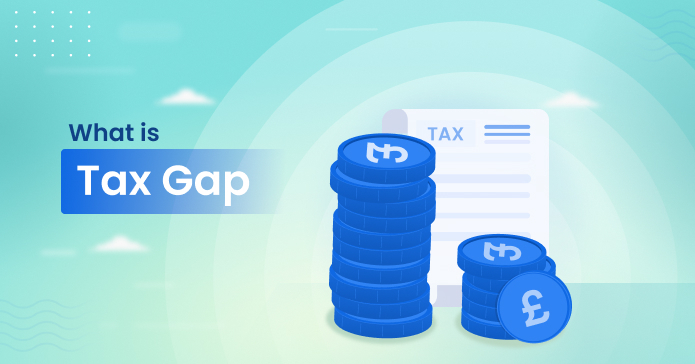For small business owners, accountants, and finance professionals in the UK, understanding the concept of the tax gap is critical. Not only does it shed light on the country’s compliance challenges, but it also impacts the ways businesses operate, interact with HMRC, and contribute to the Treasury.
This post offers a comprehensive breakdown of the tax gap, covering its definition, components such as HMRC’s Self-assessment and PAYE tax gaps, as well as its implications for UK business owners. Finally, we’ll outline how Debitam can aid businesses during fiscal uncertainties.
What is the Tax Gap?
The tax gap is the difference between the theoretical amount of tax owed to HMRC and what is actually collected. It represents non-compliance, whether due to intentional evasion, accidental errors, or unpaid debt.
Historically, the tax gap in the UK has fluctuated but remains a notable issue. For instance, in the 2023-24 tax year, the UK’s tax gap stood at 3% of total potential liabilities, amounting to £36 billion, according to HMRC.
The tax gap is a useful metric for understanding compliance across taxes like Income Tax, National Insurance contributions (NICs), VAT, and Capital Gains Tax (CGT), and it helps businesses grasp their role in improving accountability.
What Causes the Tax Gap?
The tax gap arises from various sources, ranging from honest mistakes to deliberate fraud. Here are the main contributors:
- Errors – Accounting for around 15% of the tax gap, these involve miscalculations or misunderstandings of tax obligations.
- Non-payment – Often related to bankruptcy or insolvency, this contributes approximately 13%.
- Legal Interpretation Issues – Disputes over differing interpretations of tax laws account for 10%.
- Avoidance – Using legal loopholes to reduce owed tax constitutes 4%.
- Evasion & Criminal Behaviour – Evasion, hidden income, and fraud make up more than 50%.
For UK businesses, awareness of these issues can prevent penalties, improve compliance, and preserve trust between taxpayers and HMRC.
HMRC Tax Gap Components and Definitions
To fully grasp the tax gap, it’s essential to explore its components across distinct tax regimes. Below is a breakdown:
1. Self Assessment (SA) Tax Gap
Self Assessment accounts for the largest share of the tax gap, making up 60.8% in 2023-24. This includes tax discrepancies from:
- Business taxpayers (sole traders, small partnerships),
- Non-business individual taxpayers,
- Large partnerships (5+ partners).
2. PAYE (Pay-As-You-Earn) Tax Gap
This gap represents discrepancies in employer obligations for Income Tax and NICs under the PAYE system. By the 2023-24 tax year, PAYE’s tax gap amounted to 1% of liability or £3.9 billion. The small and mid-sized businesses contribute heavily due to unmet reporting expectations.
3. Hidden Economy Tax Gap
This refers to income that goes unreported, often by individuals taking on cash-in-hand work ("moonlighters") or entirely unregistered businesses ("ghosts"). Despite being small (1.5 billion), the hidden economy undermines fair competition.
4. VAT Gap
The UK’s VAT gap measures lost revenue from underreported or unpaid VAT. Businesses should pay close attention to the Making Tax Digital (MTD) initiative to minimise VAT-related compliance issues.
5. Capital Gains Tax (CGT) Gap
While smaller compared to the SA or PAYE gaps, discrepancies in CGT filing can attract significant penalties. Many occur due to errors in filing gains from property, stocks, or assets.
Why Does the Tax Gap Matter to UK Businesses?
For UK businesses, the tax gap’s implications extend far beyond abstract statistics. Here’s why it matters:
1. Lost Revenue Impacts Public Services
The tax gap directly reduces HMRC's revenue, limiting funds for essential services like healthcare, infrastructure, and education—which businesses also rely on.
2. Increasing Scrutiny on SMEs
Small businesses are a significant contributor to the tax gap. For example, HMRC’s Random Enquiry Program (REP) often targets small and self-employed taxpayers to improve compliance.
3. Risk of Penalties
Non-compliance or filing errors can lead to hefty penalties, reputational damage, and unnecessary stress for business owners.
4. Sustain Long-term Compliance
Understanding how the tax gap affects businesses helps SMEs stay within compliance regulations and future-proof their operations amid evolving tax frameworks like MTD for Income Tax and VAT.
How Debitam Can Help
Navigating tax complexities can be overwhelming, especially when compliance directly impacts your finances. At Debitam, we are dedicated to helping small businesses, startups, and Self-employed individuals meet tax compliance requirements.
Here’s how we can support you:
- Maximise Accuracy – Our tools reduce errors in your financial reporting and Self-assessment filings, protecting you from penalties.
- Tax Efficiency – Use our resources to optimise claims and deductions, keeping more capital in your business.
- Guided Digital Solutions – Simplify VAT or SA tax returns with HMRC-compliant, user-friendly filing software.
- Proactive Alerts – Stay ahead of deadlines with reminders for key filings, from Self Assessment submissions to VAT payments.
By choosing Debitam, you gain a reliable partner to help you minimise risk, reduce non-compliance, and thrive amid fiscal challenges.
Start Closing the Tax Gap Today
The tax gap isn’t just a national concern; it’s a challenge that affects businesses like yours. Whether filing VAT or managing payroll compliance under PAYE, ensuring that your tax returns are accurate and timely is vital for business survival.
Debitam can make managing your tax affairs easier, quicker, and more accurate. Get in touch today to start closing your compliance gaps and strengthening your business’s future.













